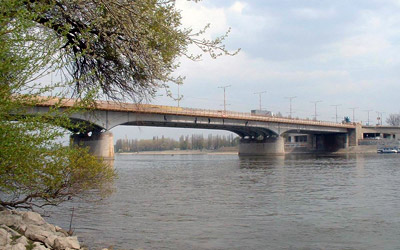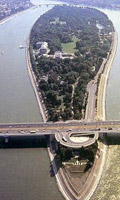Arpad Bridge
Situated at the northern end of Margaret Island, Arpad Bridge is the second longest and at present the most congested bridge in Budapest. It is named after chieftain Arpad, the leader of the first Magyar settlers of Hungary.
The construction of the bridge had been planned since the installation of the old Elizabeth Bridge in 1903, however the design competition was only launched in 1930. Its construction was started in 1939 to the plans of János Kossalka. The work was being supervised by Károly Széchy and Pál Sávoly. At the time of their planning, the 103-meter spans at the Buda side would be classified as the longest web-plate bridges of the world.
Due to World War II, the construction of the bridge was suspended in 1943 and could only be resumed in 1948. At that time, the so-called post-war "bridge battle"- i.e. the reinforcement of the endeavor to set into operation the largest possible number of Danube bridges as soon as possible and with the lowest possible material consumption - was in full swing. For this reason, the installation of the steel structure only included the parts attached to the two middle head-beams of the bridge, thus narrowing the bridge-deck from the originally planned 27.6 meters to 13 meters. The bridge was finally inaugurated on 7 November 1950, yet the socialist government named it after Stalin instead of the originally proposed Arpad. Finally, it was rechristened Arpad in 1958.

Arpad Bridge is 928 meters long
Until the post-war reconstruction of the Northern Connecting Railway Bridge in 1955, the tramway rails of the Arpad Bridge were also used for the carriage of goods by railway. In 1969, comprehensive repairs were carried out, including the renovation of the draining equipment and the replacement of the paving damaged by excessive goods traffic.
The narrow bridge-deck could not keep up with the considerable growth of public traffic so that it had to be extended to a dual three-lane road between 1981 and 1984. At that time, the passing tram line was also modernized. With about 150 000 cars passing through each day, the Arpad Bridge is nowadays the most congested bridge in Budapest.
The bridge is 928 meters long and 35.4 meters wide. It contains six traffic lanes, as well as two tram lines in the middle and also a pavement and a bicycle lane each at both sides.
 Margaret Island |
An underground station of M3 is located at the Pest side, from where you can cross the bridge by the tram line 1 or the bus number 106, respectively. Bus number 26, which turns off to Margaret Island at the middle of the bridge, also sets off here. Margaret Island is accessible by car as well, however you can only drive in until the car park at the Northern part, as the island is closed for vehicular traffic. Over the last years, modern office blocks have been built in the area.
The Vasarely Museum welcomes its visitors at Szentlélek Square, located at the Buda end of the bridge. From there, it takes only a couple of minutes to walk over to the Main Square of Óbuda dating from the antiquity and having a rather special atmosphere. The Main Square houses the City Hall, the Kassák Museum and the Óbudai Museum hosting a local history exhibition. The Postakocsi Restaurant, also to be found here, is known to be have been the starting point of stage coaches heading towards Vienna from September 1752. You can well have a glimpse at one of these vehicles in the cellar of the restaurant. On the other side you can discover another deservedly famous restaurant called "Új Sipos Halászkert". It offers traditional Hungarian dishes and specialties, which you can consume either in one of the smartly furnished halls or in the impressive open-air section or even in the basement.
During the construction works of a flyover leading to Szentendre, some Roman archaeological finds were being discovered under the Óbuda slope ramp. They can now be visited at the local subway and its surroundings. South from the Buda end of the bridge, you can find a smaller church called St. Peter and Paul Central Parish Church. It was built between 1744 and 1749.
|
|||||||||||||||||||||||||||||
|
|||||||||||||||||||||||||||||
External links
- Új Sipos Halászkert - A famous restaurant with excellent fish specialities
BRIDGES OF BUDAPEST
DID YOU KNOW?
The 5,000 metric ton ironwork of Margaret Bridge inaugurated in 1876 was manufactured in France and transported to Budapest in larger parts by railway. The roadway was covered by pine wood blocks, the two pavements at the edges were paved by oak.Read more


